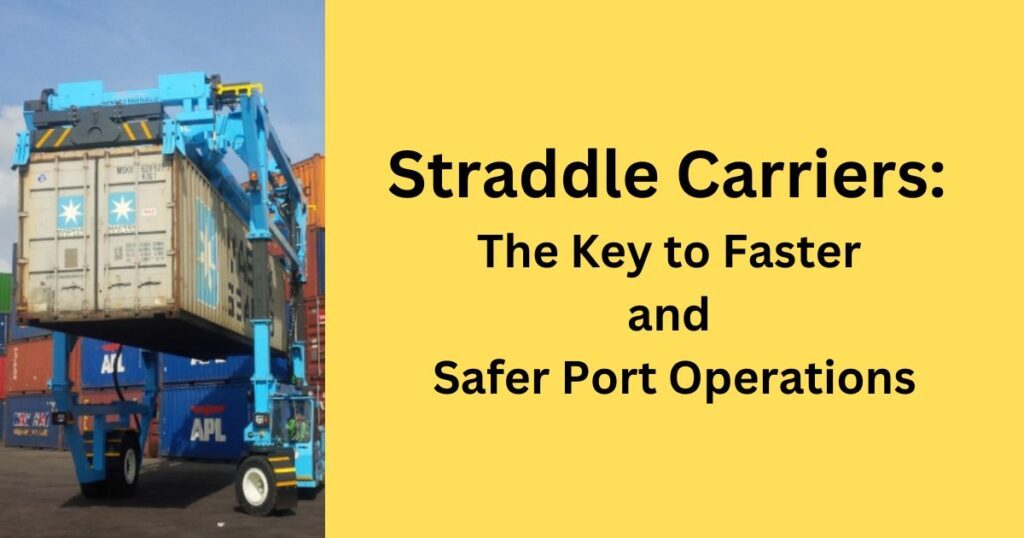Introduction
In the fast-paced world of global trade, port operations are constantly evolving to accommodate increasing cargo volumes. Efficient handling of shipping containers is essential to ensure smooth supply chain management, reduce turnaround times, and maintain safety standards. One of the most effective solutions in modern ports is the straddle carrier. These towering, self-propelled machines are vital in container handling, ensuring seamless loading, unloading, and transportation within port terminals.
What is a Straddle Carrier?
A straddle carrier is a unique vehicle designed for port terminals and container yards to lift and move shipping containers. In contrast to other machinery, it retrieves containers from above, allowing for stacking in multiple layers and improved space utilization. Straddle carriers usually feature four to eight wheels and can raise containers to considerable heights, enhancing their manoeuvrability and making them ideal for bustling port settings.
Advantages of Straddle Carriers in Port Operations
- Increased Efficiency
Straddle carriers enhance port efficiency by enabling rapid container movement. Since they do not require additional lifting equipment like cranes, they can independently transport containers from ships to storage areas or trucks without unnecessary delays. This autonomy reduces congestion in the terminal and improves overall throughput.
- Improved Safety
Safety is a primary concern in port operations, and straddle carriers significantly prevent accidents. Their enclosed operator cabins provide better visibility and control, reducing the risk of collisions. Additionally, modern straddle carriers are equipped with advanced safety features such as anti-collision systems, automated braking, and real-time monitoring to ensure the secure handling of cargo.
- Versatility and Flexibility
Unlike other container-handling equipment, straddle carriers can operate on various terrains without requiring fixed infrastructure. They can seamlessly move between different port sections, handling various container sizes and weights. This flexibility makes them indispensable for ports that manage diverse cargo shipments.
- Reduced Labor Costs
Straddle carriers minimize the need for manual labour in container handling. Fewer workers must supervise operations since they can independently transport and stack containers. This reduction in labour dependency cuts costs and decreases human-related errors, leading to smoother workflows.
- Enhanced Space Utilization
Straddle carriers have the ability to stack containers as high as four levels, optimizing the storage capacity in port terminals. This capability for vertical stacking is crucial for ports that have restricted ground space, allowing for effective land utilization while handling rising cargo volumes.
Technological Advancements in Straddle Carriers
The evolution of straddle carrier technology has led to significant performance, automation, and sustainability improvements. Some of the latest advancements include:
Automated Straddle Carriers:
Many contemporary ports use autonomous or semi-autonomous straddle carriers. These machines feature AI navigation systems that enable them to operate with minimal human intervention, increasing efficiency and reducing operational costs.
Eco-Friendly Straddle Carriers:
With a growing focus on sustainability, manufacturers are developing hybrid and fully electric straddle carriers to reduce carbon emissions. These environmentally friendly models contribute to greener port operations while complying with strict emission regulations.
Telematics and Remote Monitoring:
Advanced telematics systems enable port operators to monitor straddle carrier performance in real time. By analyzing data on fuel consumption, maintenance needs, and operational efficiency, ports can optimize logistics and reduce downtime.
Comparing Straddle Carriers with Other Container Handling Equipment
Straddle Carrier vs Reach Stacker:
While reach stackers are effective in lifting and moving containers, they have limitations in stacking height and manoeuvrability. Straddle carriers, on the other hand, can transport containers over longer distances within the port and stack them more efficiently.
Straddle Carrier vs. Gantry Crane:
Gantry cranes typically load and unload ships but require extensive infrastructure and space. Straddle carriers complement gantry cranes by swiftly moving containers from quaysides to storage yards, ensuring a continuous workflow.
Straddle Carrier vs. Side Loader Forklift:
Side loader forklifts are suitable for handling long and heavy loads in tight spaces but are not ideal for stacking multiple containers. Straddle carriers offer superior stacking capabilities, making them more efficient for large-scale container handling operations.
Future of Straddle Carriers in Port Operations
The future of straddle carriers looks promising, with ongoing innovations focusing on automation, sustainability, and efficiency. By integrating advanced technologies, straddle carriers are set to play an even more crucial role in optimizing port operations.
Conclusion
Straddle carriers have transformed port operations by providing exceptional efficiency, safety, and flexibility in container handling. Their capability to independently transport and stack containers makes them an essential asset for modern ports striving to enhance productivity. With ongoing advancements in automation and sustainability, straddle carriers are set to remain vital in shaping the future of global trade logistics.














